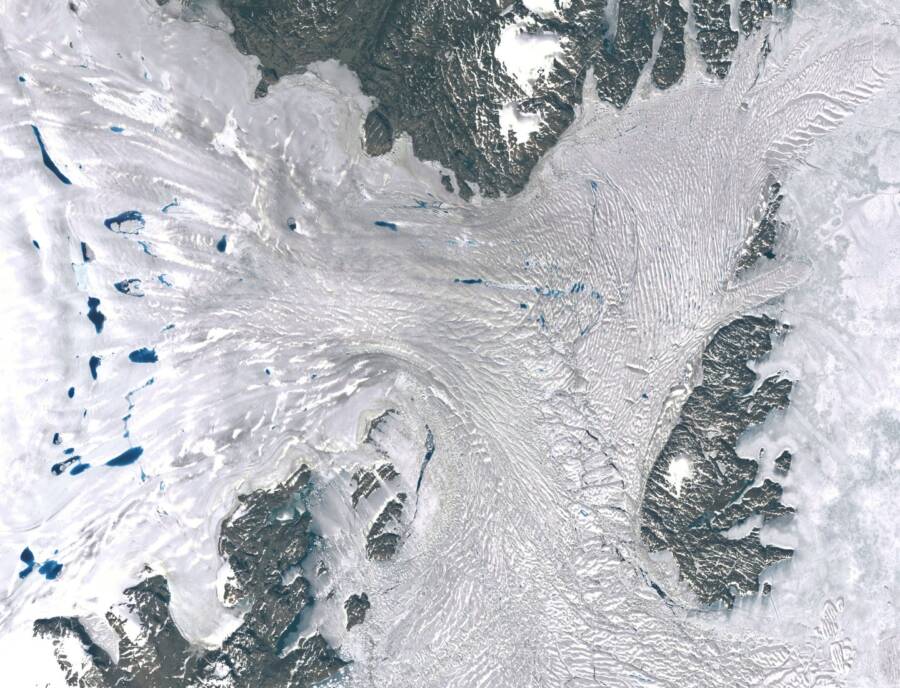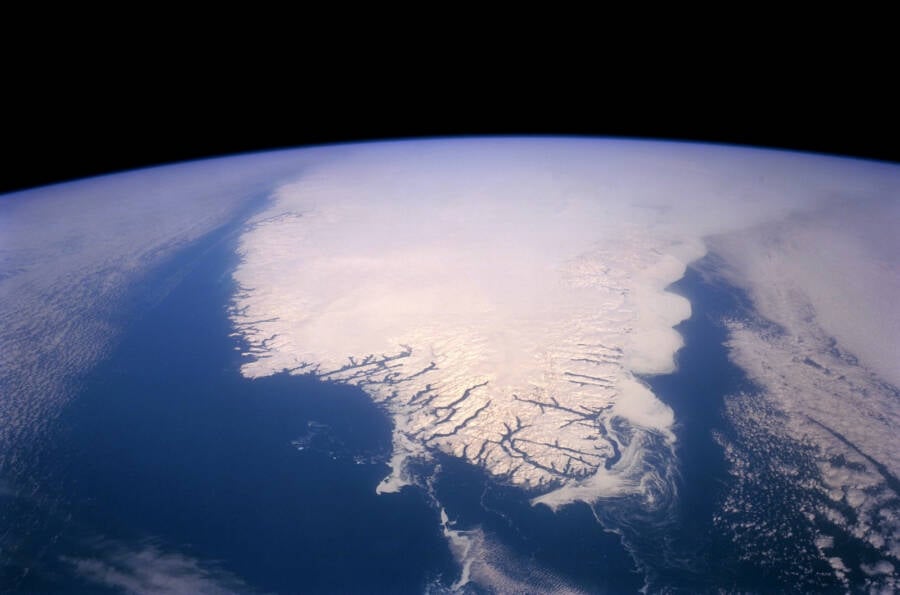Greenland is losing ice at a rate 20 percent faster than previously estimated.

Wikimedia CommonsGreenland’s Kangerllussuaq Glacier, which has retreated 6.2 miles since 1900.
Greenland’s glaciers are melting at a much faster rate than expected — and as a result, the island itself is growing.
According to two recent studies — one published in Nature, the other in Geophysical Research Letters — Greenland is gradually gaining height as melting glaciers relieve pressure on the island’s bedrock, allowing it to rise.
This process has been going on slowly since the end of the last ice age, roughly 11,700 years ago, but it has dramatically increased in recent years due to climate change. Between the melting of the Greenland Ice Sheet and the island’s peripheral glaciers and ice rivers, the country is shedding upwards of 200 gigatons of ice each year.
The effect is two-fold: the retreating of the ice sheet takes a significant amount of weight off Greenland, and melting glaciers contribute a lot of freshwater into the oceans, which can impact currents and temperature regulation.
According to one study, the glacial ice loss in some areas is responsible for nearly one-third of Greenland’s total vertical land motion.
“What we’re seeing is a synchronized response of Greenland’s glaciers to widespread warming,” Chad Greene, a glaciologist at the NASA Jet Propulsion Laboratory and lead author of the Nature study, tells All That’s Interesting via email. “Nearly every glacier in Greenland has retreated over the past few decades, and they’re showing no sign of slowing down.”

NASAThe Zachariae Isstrom glacier circa 1999.

NASAThe same glacier circa 2022.
Based on satellite images taken between 1985 and 2022, Dr. Greene and his team created a comprehensive overview of the status of Greenland’s ice sheet over 40 years, combining more than 200,000 observations of glacier end points across the country.
Through these observations, scientists determined that since 1992, Greenland has lost nearly five trillion metric tons of ice. Traditional methods of measurement have determined that this has caused the sea level to rise roughly half an inch, but Greene and his colleagues’ observations also accounted for what traditional methods do not — the erosion of glaciers’ end points in fjords across the island.
“Most of the ice lost to retreat previously filled deep fjords around Greenland’s periphery. When that ice was lost, ocean water flowed in to take its place, meaning there was no net change in sea level,” Greene said. “However, when ice gets taken out of a fjord, it’s like taking a plug out of a drain — suddenly the massive ice sheet upstream of the fjord can start flowing toward the ocean faster, and that’s what causes sea level rise.”
When factoring in this process, known as glacial terminus retreat, it accounts for an additional one trillion metric tons of lost ice.
To exemplify, the European Space Agency said that would be about the same amount of ice as a cube with an area larger than Manhattan and a height greater than Mount Everest.
“It was already known that Greenland has lost about 5,000 Gt of ice that has directly contributed to sea level rise over the past decades, and our findings do not change that estimate,” Greene said. “What we document is an additional form of ice loss that hasn’t directly impacted sea level rise, but equates to 1,000 Gt of loss that has other knock-on effects that go beyond Greenland.”
As the Geophysical Research Letters study observes, this rapid melting is also causing Greenland’s bedrock to rebound, making the ground rise at a rate of roughly 0.3 inches per year in some locations, such as near the Kangerllussuaq Glacier in southeast Greenland. Since 1900, this glacier has retreated 6.2 miles.
The lead author of the study, Danjal Longfors Berg, tells All That’s Interesting, “We have two main contributing factors of land motion in Greenland; Elastic deformation and viscoelastic deformation.”
“Elastic deformation can be described as a spring. Greenland’s ice sheet and the peripheral glaciers in the Arctic have been losing mass due to global warming. As less mass pushes down on the lithosphere, the land rises again,” Berg says. “The elastic land deformation is instantaneous and sensitive to the location of the mass loss. This means that we detect the land rising more rapidly close to the major glaciers in Greenland and other places where Greenland is losing the most mass.”

Public DomainGreenland’s ice sheet as seen from space.
When combined with other techniques, the rate of vertical land motion can lead to more precise measurements of how much ice is being lost and how much the sea level is rising.
“Greenland will slowly rise as the Greenland’s ice sheet melts,” Berg says. “We have measured up to 20 cm over a decade, resulting in two meters over a century. This is faster than the current/projected sea level rise around Greenland. New land, such as small islands and skerries, will emerge.”
This ice loss also has ramifications that extend far beyond the borders of Greenland. As the ice melts, it also contributes a significant amount of freshwater into the ocean, which has the potential to disrupt a system of currents known as the Atlantic Meridional Overturning Circulation, which includes the Gulf Stream.
The Gulf Stream carries warm tropical waters to the southeast coast of the U.S. and parts of Europe, making the water temperatures more mild. In theory, the continuous rapid melting of Greenland’s ice could start to affect global water temperatures as well.
Overall, Greenland is shedding roughly 20 percent more ice than previously estimated — and this could have serious implications going forward.
After learning about the rapidly increasing loss of ice in Greenland, take a moving look at the impact of climate change around the world. Or, read about Erik the Red, the Viking who first settled Greenland.





